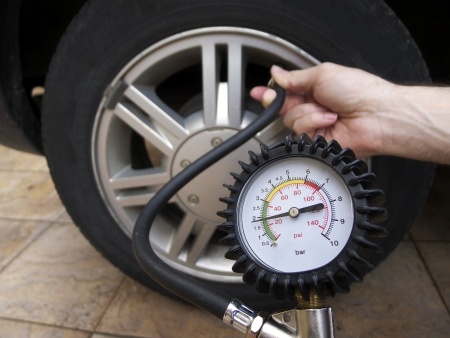It's a cold winter morning, the temperature dropped below zero, you come in to your garage and want to check the tire pressure on your car.
You can read the right inflation pressure on a tire placard, which is usually located on a car door edge but also may be on a door jam, glove box door or inside a trunk lid. The tire placard shows the vehicle manufacturer's recommended tire pressure, in this case, let’s assume it is 2.0 bar (29 psi). You check the pressure and it is about 1.8 bar (26psi), lower than the recommended pressure. Then, you inflate the tire on 2.0 bar. Is it the right pressure? Unfortunately not!

Low temperature has a significant effect on a tire pressure. When the outside temperature drops, the air inside the tire contracts and the tire pressure drops. The temperature in your garage is higher than the outside temperature, suppose it is about +20°C (68 °F). When you get out of the garage the tire pressure drops from 2.0 bar to 1.8 bar, but it is not equal to the recommended pressure. This is the reason why we should add more air in the tire.
If you check the tire pressure in cold weather, when your vehicle is outside, the tire should be inflated to the manufacturer's recommended tire pressure.
The rule of thumb is that for every 10-degree Celsius (18°F) drop in temperature the pressure should be increased for 0.1 bar (1.45 psi). For e.g. If the difference between the inside and outside temperature is 20°C (36°F) the tire pressure (in the garage) should be increased for 0.2 bar (2.9 psi) in relation to the recommended pressure.
A winter tire structure is different compared to a summer tire. The winter tire is made of a softer compound, the tread design is deeper with great number of small sipes. All of these features provide better winter performances on ice and snow, but the tire stability and responsiveness are reduced. Therefore, it's especially important to set the correct tire pressure. The pressure loss of 0.3 bar (4.35 psi), for example, affects negatively on car handling, tire traction, and tire durability.
Related articles:
- Tyre pressure in the summer - Read about the outside temperature impact on the tyre pressure?
- Tyre pressure impact on tyre mileage, fuel consumption, excessive tyre wear, tyre blowout, car handling, rolling resistance, hydroplaning and ride comfort.
- Continental tyre air pressure table for passenger cars and 4x4 vehicles.
- Tire pressure conversion charts - bar to psi, psi to bar.
